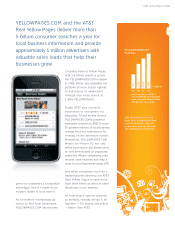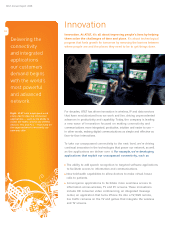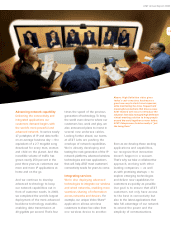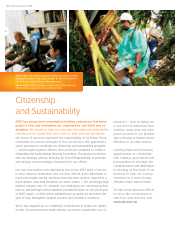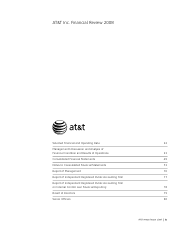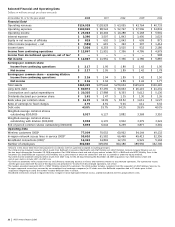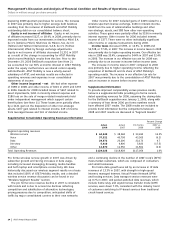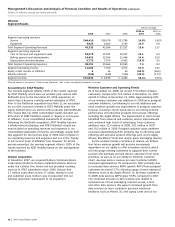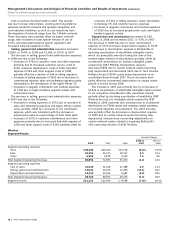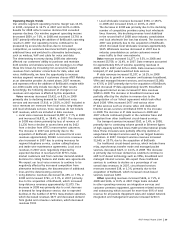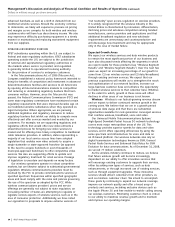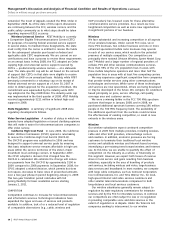AT&T Wireless 2008 Annual Report Download - page 29
Download and view the complete annual report
Please find page 29 of the 2008 AT&T Wireless annual report below. You can navigate through the pages in the report by either clicking on the pages listed below, or by using the keyword search tool below to find specific information within the annual report.
AT&T Annual Report 2008
| 27
third-generation network continues to expand. The growth in
data ARPU was partially offset by a decline in voice service
ARPU of 6.5% compared to 2007. The decline in voice service
ARPU is the result of a decrease in postpaid voice overage
charges, increases in our Family Talk® and reseller customers,
which have lower ARPU than traditional postpaid customers,
lower roaming revenues due to acquisitions and rate
negotiations as part of roaming cost savings initiatives,
slowing international growth and lower regulatory cost
recovery charges. We expect continued pressure on
voice service ARPU.
In 2007, data service ARPU grew 46.9% compared to 2006.
The continued increase in data revenue was related to
increased use of text messaging, Internet access, e-mail and
other data services. The growth in data ARPU was partially
offset by a decline in voice service ARPU of 4.1% compared to
2006, reflecting a higher percentage of prepaid and reseller
customers, which provide significantly lower ARPU than
postpaid customers, and continued shifts to all-inclusive rate
plans that offer lower monthly charges.
The effective management of customer churn also is
critical to our ability to maximize revenue growth and to
maintain and improve margins. Customer churn is calculated
by dividing the aggregate number of wireless customers who
cancel service during each month in a period by the total
number of wireless customers at the beginning of each month
in that period. Our customer churn rate was 1.7% in 2008,
1.7% in 2007 and 1.8% in 2006. The churn rate for postpaid
customers was 1.2% in 2008, down from 1.3% in 2007 and
1.5% in 2006. The decline in postpaid churn reflects higher
network quality and broader coverage, more affordable rate
plans as well as exclusive devices and free mobile-to-mobile
calling among our wireless customers.
Wireless Operating Results
Our wireless segment operating income margin was 22.5%
in 2008, 16.4% in 2007 and 12.2% in 2006. The higher margin
in 2008 was primarily due to revenue growth of $6,651,
which exceeded our increase in operating expenses of $2,587,
which included a decrease in depreciation and amortization
of $1,309. The higher margin in 2007 was primarily due to
revenue growth of $5,147, which exceeded our increase in
operating expenses of $2,699.
Service revenues are comprised of local voice and data
services, roaming, long-distance and other revenue. Service
revenues increased $5,732, or 14.8%, in 2008 and $4,890,
or 14.5%, in 2007 and consisted of:
• Datarevenueincreasesof$3,647,or52.5%,in2008
and $2,692, or 63.3%, in 2007. The increase in 2008 is
primarily due to the increased number of data users
and the above noted increase in data ARPU of 33.8%.
Our significant data growth also reflects an increased
number of subscribers using our 3G network. The
increase in 2007 was related to increased use of text
messaging and Internet access services, which resulted
in an increase in data ARPU of 46.9%. Data service
revenues represented approximately 23.9% of our
wireless segment service revenues in 2008 and 18.0%
in 2007.
• Voicerevenueincreasesof$2,076,or6.6%,in2008and
$2,135, or 7.3%, in 2007. The increase in 2008 was
primarily due to an increase in the number of average
wireless customers of approximately 14%, partially offset
by a decline in voice ARPU of 6.5%. The increase in
2007 was primarily due to an increase in the average
number of wireless customers of approximately 12%,
partially offset by a decline in voice ARPU of 4.1%.
Included in voice revenues for both periods were
increases in long-distance and net roaming revenue
due to increased international usage.
Equipment revenues increased $919, or 22.9%, in 2008
and $257, or 6.9%, in 2007. The increase in both 2008 and
2007 was due to higher handset revenues reflecting increased
gross customer additions and customer upgrades to more
advanced handsets. The increase in 2007 was partially offset
by equipment discounts and rebate activity.
Cost of services and equipment sales expenses
increased $2,087, or 13.1%, in 2008 and $934, or 6.2%, in
2007. The 2008 and 2007 increases were primarily due to
increased equipment sales expense of $2,005 and $1,140,
respectively, resulting from the overall increase in sales as
well as an increase in sales of higher-cost 3G devices, the
introduction of the Apple iPhone 3G (in 2008) and iPhone
(in 2007) handsets as well as an increase in the number of
handset accessory sales. The 2008 per-unit accessory cost
decreased from 2007, while the 2007 per-unit accessory
cost increased from 2006. Total equipment costs continue
to be higher than equipment revenues due to the sale
of handsets below cost, through direct sales sources, to
customers who committed to one-year or two-year
contracts or in connection with other promotions.
Excluding equipment sales, costs of services remained
relatively flat in 2008 as the result of higher regulatory fees
of $204 due to revenue growth, reseller costs of $145, and
interconnect and other costs of $141, substantially offset
by lower incollect roaming costs of $249, network system
costs of $132 and long-distance costs of $27.
The $145 increase in reseller costs is attributable to higher
license, maintenance and other reseller costs partly offset by
cost reductions from the migration of network usage from
the T-Mobile USA (T-Mobile) network in California and Nevada
to our networks in these states. Our remaining purchase
commitment to T-Mobile for this transition period was $42
and $51 at December 31, 2008 and 2007, respectively.
The $141 increase in interconnect and other costs
primarily related to increased usage and integration costs
related to Dobson. The $132 decrease in network system
costs is the result of benefits from network and systems
integration and cost-reduction initiatives of $218, and lower
data processing and payroll costs of $109, partly offset by
incremental rents related to Dobson and general building
expense increases of $124, and hurricane and other
incremental network costs of $99.


